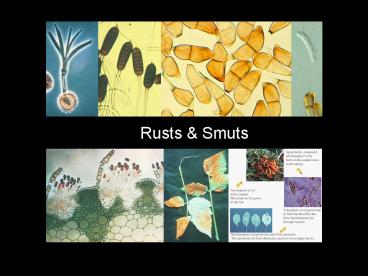Rusts PowerPoint PPT Presentation
1 / 15
Title: Rusts
1
Rusts Smuts
2
Three Classes of Basidiomycota
Hymenomycetes dolipore septum holobasidia
phragmobasidia Ustilaginomycetes
"simple dolipore"
phragmobasidia teliospores
Urediniomycetes simple septum
phragmobasidia teliospores
3
Urediniomycetes Uredinales - the Rusts 5000
species 140-150 genera Ustilagniomycetes
Ustilaginales - the Smuts 1200 species 50
genera All are parasitic on plants, often
causing great damage to many cultivated crops
Heterothallic Obligate biotroph - incapable
of completing life cycle saprobically
4
Teliomycetes - old class, included Uredinales
and Ustilaginales based on possession of the
teliospore Teliospore site of
karyogamy technically part of the basidium
5
teliospore germinates, gives rise to a short germ
tube of determinate growth known as the
promycelium. Promycelium site of meiosis
formation of sterigmata and basidiospores
6
- Uredinales
- Rust fungi may produce as many as five different
- spore-producing stages (0, I, II, III, IV) in
their life cycles - Heteroecism
- two taxonomically different host plants in order
to - complete life cycle
- alternate host stages 0, I
- primary host stages II, III
- Autoecism
- - entire life cycle completed on a single host
species
7
Stage 0 and I produced on alternate host
Stage 0 Spermogonia bearing spermatia (n) and
receptive hyphae (n)
helios.bto.ed.ac.uk/bto/microbes/biotroph.htm
- fertilization of the receptive hyphae by
spermatia initiates - the dikaryon and the formation of aecia
8
Stage I Aecia bearing aeciospores (nn)
- aeciospores infect primary host
- e.g., aeciospores produced on alternate host
(e.g., Barberry) - infect primary host (e.g., grasses)
9
Stage II Uredinia (j) bearing urediniospores
(nn)
helios.bto.ed.ac.uk/bto/microbes/biotroph.htm
- reinfect primary host
- amplifies disease within primary host
- uredinia can eventually develop into telia
10
Stage III Telia bearing teliospores (nngt2n)
- final stage on primary host
- overwinters as dikaryon
11
Stage IV Basidia bearing basidiospores (n)
- in the spring teliospore germinates a
promycelium - diploid nucleus migrates into the promycelium
and - undergoes meiosis
- four haploid nuclei migrate into developing
sterigmata - are incorporated into basidiospores
- basidiospores reinfect alternate host
12
Life Cycle of Puccinia graminis
I
SUMMER
aecia on barberry (nn)
urediniospores (nn) airborne
spermatia (n) insect transported to receptive
hyphae (n) heterothallic
II
aeciospores (nn) airborne
O
F A L L
uredinia on grass from infection by aeciospores
or urediniospores
spermagonia on barberry from infection by
basidiospores
basidiospore (n) airborne
meiosis
III
S P R I N G
IV
telia on grass
teliospore (2n) germinating on straw
with promycelium and basidiospores (n)
teliospore on straw (nn)
karyogamy (2n)
WINTER
13
Life cycle patterns of the Uredinales 1.
macrocylic forms- all five reproductive stages
2. demicyclic forms- the uredinial stage is
absent 3. microcyclic forms- both aeciospores
and urediniospores are absent teliospore is
the only binucleate spore produced
Heteroecism- two taxonomically different host
plants in order to complete their life cycles.
Autoecism- completes its entire life cycle on a
single host species
14
Examples of distantly related hosts Puccinia
graminis 0 and I on barberry bushes (Berberis
vulgaris dicot) II and III on various grasses
(monocot) Cronartium ribicola 0 and I on white
pines (gymnosperms) II and III on currants
gooseberries (angiosperms) Uredinopsis osmundae
0 and I on the balsam fir (Abies balsamea
gymnosperm) II and III on the cinnamon fern
(Osmunda cinnamomia)
15
- Ustilaginales
- no sex organs
- monokaryons nonpathogenic
- dikaryon pathogenic
- heterothallic mating of
- compatible spores
- teliospores

